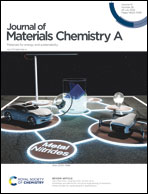Hedging Li dendrite formation by virtue of controllable tip effect†
Abstract
The tip effect intensifies charge density onto some salient areas with large curvatures and exacerbates Li dendrite formation, which reduces the cycle life of lithium metal batteries (LMBs) and probably leads to safety issues. However, by means of elaborately controlling the distribution of nano-tips, such an adverse effect can be employed to regulate the surface electric field and realize uniform lithium deposition on 3D substrates. This innovative concept was validated by a typical model with Ag nanoparticles and graphene aerogel (Ag/GA), which can mitigate the inhomogeneous current distribution caused by the uncontrollable wrinkles/edges of GA and densify the lithium deposition. We also identify the intrinsic influencing factors (size and distribution) of nano-tips for Li plating and illustrate the detailed process of Li nucleation/growth on Ag/GA anodes. Electrochemical tests show that Ag/GA anodes in a symmetric cell exhibit lower nucleation overpotential, better rate capability and longer cycle life than cells assembled by intact graphene aerogel. More importantly, the excellent electrochemical performances of Ag/GA anodes are also verified in an LiFePO4 coupled full cell with minimal degradation in capacity (17.1%) over 500 cycles under a charge/discharge current of 1C. This study not only provides new insight into the role of the tip effect, but also demonstrates an effective strategy to suppress and even eliminate Li dendrite formation.



 Please wait while we load your content...
Please wait while we load your content...